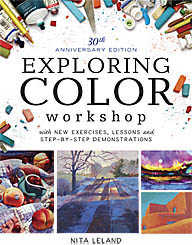Collage Lamination
Someone in my watercolor class requested a lesson on applying rice or mulberry paper to watercolor paper to create a textured surface to paint on, so that's what we did yesterday. Students brought in unryu or other lightweight Asian papers, some with fibers running through them and others plain. We discussed terminology first: is it rice paper or mulberry? Rice paper has become a generic term describing papers that may be made of rice straw, mulberry, bamboo or hemp. Here is a helpful article in Wikipedia with more information on rice papers.
 I crumpled a piece of rice paper into a ball, then flattened it out. To adhere the rice paper, I brushed fluid acrylic matte medium liberally onto a piece of 140# cold press watercolor paper. Then I placed the rice paper on the surface, allowing some of the wrinkles to remain. I patted it down with a damp sponge so the rice paper would make contact and bond with the watercolor paper. I usually use a soft brayer for this, but didn't have it with me yesterday. That's all there is to it. Wait until it is dry so you don't get acrylic medium in the hair of your good watercolor brushes. It's fun to see what watercolor paint does on this surface, crawling into the ridges in some places, making dark crinkly lines and almost disappearing in other areas.
I crumpled a piece of rice paper into a ball, then flattened it out. To adhere the rice paper, I brushed fluid acrylic matte medium liberally onto a piece of 140# cold press watercolor paper. Then I placed the rice paper on the surface, allowing some of the wrinkles to remain. I patted it down with a damp sponge so the rice paper would make contact and bond with the watercolor paper. I usually use a soft brayer for this, but didn't have it with me yesterday. That's all there is to it. Wait until it is dry so you don't get acrylic medium in the hair of your good watercolor brushes. It's fun to see what watercolor paint does on this surface, crawling into the ridges in some places, making dark crinkly lines and almost disappearing in other areas.
You can also lay thinner rice paper on the support and brush the medium directly onto it. The medium will soak through and adhere the paper to the support. In a technique called "overlay" you can adhere rice paper to a watercolor painting to create a misty effect or to tone down aggressive colors in a background. For these techniques it's best not to use sumi-e papers, which have a smooth surface on the back that might prevent the medium from soaking through the paper.
These techniques are all shown in Creative Collage Techniques: A Step-by-Step Guide.
 I crumpled a piece of rice paper into a ball, then flattened it out. To adhere the rice paper, I brushed fluid acrylic matte medium liberally onto a piece of 140# cold press watercolor paper. Then I placed the rice paper on the surface, allowing some of the wrinkles to remain. I patted it down with a damp sponge so the rice paper would make contact and bond with the watercolor paper. I usually use a soft brayer for this, but didn't have it with me yesterday. That's all there is to it. Wait until it is dry so you don't get acrylic medium in the hair of your good watercolor brushes. It's fun to see what watercolor paint does on this surface, crawling into the ridges in some places, making dark crinkly lines and almost disappearing in other areas.
I crumpled a piece of rice paper into a ball, then flattened it out. To adhere the rice paper, I brushed fluid acrylic matte medium liberally onto a piece of 140# cold press watercolor paper. Then I placed the rice paper on the surface, allowing some of the wrinkles to remain. I patted it down with a damp sponge so the rice paper would make contact and bond with the watercolor paper. I usually use a soft brayer for this, but didn't have it with me yesterday. That's all there is to it. Wait until it is dry so you don't get acrylic medium in the hair of your good watercolor brushes. It's fun to see what watercolor paint does on this surface, crawling into the ridges in some places, making dark crinkly lines and almost disappearing in other areas. You can also lay thinner rice paper on the support and brush the medium directly onto it. The medium will soak through and adhere the paper to the support. In a technique called "overlay" you can adhere rice paper to a watercolor painting to create a misty effect or to tone down aggressive colors in a background. For these techniques it's best not to use sumi-e papers, which have a smooth surface on the back that might prevent the medium from soaking through the paper.
These techniques are all shown in Creative Collage Techniques: A Step-by-Step Guide.
Labels: collage, rice paper, techniques, tutorials





0 Comments:
Post a Comment
<< Home